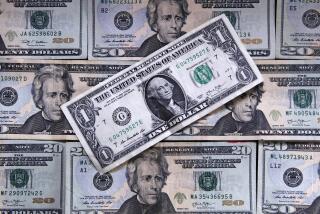Tips on How Small Investors Can Buy T-Bills
- Share via
When you buy a Treasury security, you are simply lending your money to the U.S. government to help it finance its expenditures and debts.
Treasury bills come in maturities of three months, six months and one year and require minimum investments of $10,000, increasing in $5,000 increments to $1 million. They do not pay interest, but instead must be bought at a discount from face value. The difference between the purchase price and the amount you are paid at maturity is, in effect, the interest on the bill.
You also can buy Treasury notes, with maturities between two and 10 years, or Treasury bonds, with maturities of 10 to 30 years. They carry smaller minimum investments and pay regular interest.
Treasuries can be bought from banks and brokerage houses, but these institutions charge fees as high as $50. You can avoid the charges by buying directly from Federal Reserve branches through the mail or in person.
To buy, you must open a Treasury Direct account by mail or in person at a Federal Reserve branch. A purchase requires mailing or bringing in a cashier’s check or certified personal check to the Fed branch. Most individual investors submit what are called “noncompetitive” bids, meaning that they accept the going average rate and yield, set at auctions held each Monday for three- and six-month bills and once a month for one-year issues.
For more information on how to buy Treasuries, call the Fed’s recorded help line at (213) 688-0068. Information on rates and yields can be obtained at (213) 688-0069. And if you still need help from a staff member or wish to request an account form or information sheet, call (213) 624-7398.
More to Read
Inside the business of entertainment
The Wide Shot brings you news, analysis and insights on everything from streaming wars to production — and what it all means for the future.
You may occasionally receive promotional content from the Los Angeles Times.








